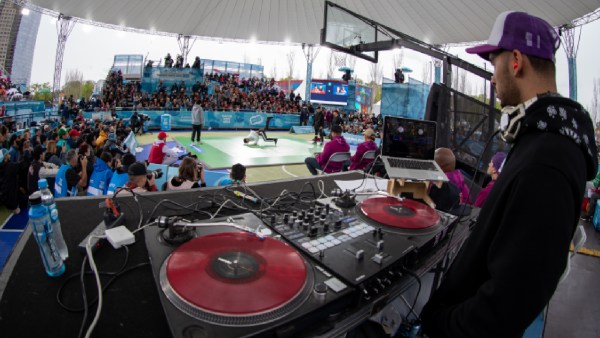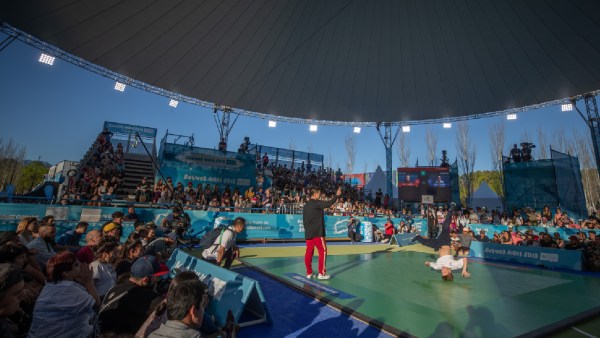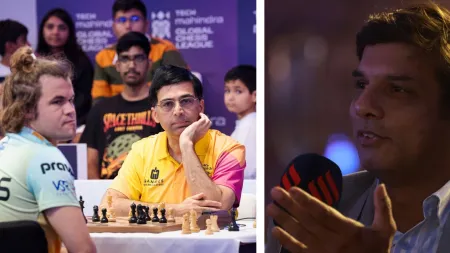2024 Paris Olympics: Breaking breaks down barriers in Games debut
Viewed from a break dancer’s imagination, the Statue of Liberty could be the first-ever ‘Freeze’ (a dramatic pause in the middle of a dynamic dance routine) that travelled from France to the USA.
But Americans didn’t bother to keep Breaking (breakdance) on their Olympic program for Los Angeles 2028, though Bronx was the ‘OG’ epicentre of the art-form in 1970s.

The famously free-spirited banlieues (suburbs) of Paris, though, didn’t forget their adored history as the world’s second-largest hip hop market, when planning their OG, the 2024 Olympic Games. France will host Breaking’s debut at sport’s grandest stage. Hip hop and graffiti might’ve taken off in the block parties of north New York across the Atlantic, but Europe has surreptitiously nurtured its own Breaking base, mainstreaming an erstwhile underground subculture.
 Victor Montalvo, also known as B-Boy Victor, of the United States, competes in the B-boy Red Bull BC One World Final at Hammerstein Ballroom, Saturday, Nov. 12, 2022, in New York. (AP File)
Victor Montalvo, also known as B-Boy Victor, of the United States, competes in the B-boy Red Bull BC One World Final at Hammerstein Ballroom, Saturday, Nov. 12, 2022, in New York. (AP File)
Paris has taken the lead in liberating sport from its clunky stadium-confines, and brought the Olympics straight out into the streets. Place de la Concorde, a popular public square at the end of Champs Elysees, will transform into an urban, no-frills Paris Games venue, hosting other unpretentious sports like BMX freestyle, skateboarding and 3×3 basketball.
The makeshift stage rig will get neatly folded away the morning after and Parisians can go about their lives as usual, with the sport leaving behind none of what sociologist Andrew Zimbalist called the useless ‘white elephants’ of Olympics.
France is bang in the middle of a historical flux, with their restless young population especially annoyed with all manners of ostentatious and needlessly opulent spending. The Olympics, with their crusty profligate ways, pretty much get disdained for being both, in most host cities. But Breaking that breaks all elitist shackles, could offer a popular little corner, that the city warms up to.
“Not only is Breaking gender-balanced, youthful and urban, it is also flexible and sustainable in that it can essentially be organised anywhere, without the need for costly new infrastructure, equipment, etc,” Jean-Laurent Bourquin, former senior advisor World Dance Sport Federation, had said in a past interview with the Indian Express. Most B-Boys and B-Girls are in fact used to performing on wood, plastic, cardboard and even concrete, with zero cribs. “Finally, the inclusion of Breaking would help to bring the 2024 Games closer to local communities in Paris and connect with the young people of France,” he added.
 A participant in action during the 2018 Youth Olympics. (Image Courtesy: World DanceSport Federation)
A participant in action during the 2018 Youth Olympics. (Image Courtesy: World DanceSport Federation)
The idea stirred in 2016 in International Olympic Committee corridors. And a 5 cm floor was laid out at the 2018 Youth Olympics in Buenos Aires, Argentina, and simply removed post the battles, so 3×3 basketball could get on next day. It was that easy.
The huge, vocal crowds in the Argentine capital pierced the resistance from IOC traditionalists, and sheer numbers from the Olympic Channel and social media went dizzy, showing very strong interest in the sport. Bourquin helped put the competitive structure to fit into Olympics program, and saw first-hand how the hip hop beats, the emcee and the crowd involvement changed perception.
“For me the most satisfying part of this Olympic journey was seeing some of the doubters do a 180 in Buenos Aires. They went from being quite sceptical to becoming some of the loudest proponents of Olympic Breaking,” he said. A 1000 one-minute video entries were received from countries as diverse as Nepal, Rwanda, El Salvador and Lithuania, whose B-Girl Nicka is incidentally a gold favourite at Paris.
Young at heart
Paris that tends to be ahead of the curve in rebellious fashion, didn’t flinch to push for this loved fringe chic sport where ‘less is more’. The haters, they knew, would carp away, mostly in English, which they would non-chalantly ignore.
The youthful Breaking goes the whole hog in being inclusive and disrupting trends, by including what Sport would scoff at as ‘old’. The dope-est (dope means brilliant in Breaking lingo) moves at Paris are expected to be unleashed by Korean B-Boy HongTen, who is 40 years old. French representative b-boy Dany-Dann, whose day job is of a nursing assistant, is 36. Really named Danis Civil, in fact, came to Metropolitan France (mainland Europe), from South American overseas territory of French Guiana and toured small French towns participating in Battles.
Breaking’s Paris venue, Concorde reflects this contrast – the public square sits under the obelisk of Louxor, the oldest monument in Paris.
Bourquin who helped pitch Breaking as sport to the IOC, insists all of Europe has pockets where the explosive sport with hip-hop beats, emcees to keep things flowing, and the drama of head to head ‘battles’ took off in the 80s. He was 17 when he attended various events in his home city of Bienne that was one of the most active in the hip hop scenes in Switzerland.
 Judges at the Olympics will score breakers based on the Trivium judging system, which scores breakers on creativity, personality, technique, variety, performativity and musicality. (Image Courtesy: World DanceSport Federation)
Judges at the Olympics will score breakers based on the Trivium judging system, which scores breakers on creativity, personality, technique, variety, performativity and musicality. (Image Courtesy: World DanceSport Federation)
Youth from Parisian suburbs though, were some of the earliest to get swept off their feet – and spin on their heads, for good measure. “When the Rock Steady Crew was on tour in France in 1982, many young people were impressed by what they saw and started to break,” he recalls. The first pitstop was the French iconic operatic theatre of Bataclan, which had a dance floor on the upper tiers. The culture then expanded to La Chapelle and the Trocadero.
When the breakers were shoved aside by ballet and ballroom dancing traditionalists, one of Paris’s most eccentric designers gave them refuge. “It is interesting to note that famous Spanish fashion designer Paco Rabanne, who lived in France, offered opportunities to dance at his place when the breakers were asked to leave The Bataclan,” Bourquin notes.
The sport, which took off with Puerto Rican and Black youth in the Bronx, has always been entwined with assorted cultural blazes borrowed from all around. The ‘break’ in Breaking comes from the percussion-only (non vocals or other instruments) slot in a song which Jamaican DJ Kool Herc prolonged for dancers to bounce to. Battles began in 1990s, and cyphers – circles formed within which B-Boys and B-Girls dance – came about thereafter.
The moves too get riffed off from Latin to kung-fu with head spins, flips, tricks, horns, flares and freezes perfected so that both the standing and floor based moves, the holding positions and acrobatic transitions, demand coordination, strength and endurance, making it a sport despite being scoffed at by old, Olympics purists.
German B-Boy Niels ‘Storm’ Robitzky, now a respected judge and coach, says Breaking of 90s drew from myriad athletic influences – a funk musician, martial art’s greatest and sport’s mightiest. “The history of dance personifies a combination of 3 public figures that were pretty important to development: 1. James Brown for the music and drive; 2. Bruce Lee for his swiftness, the kingly character and standing up for what he believes is right. As well as the Tao of Jeet Kune Do, where a great part of it is to work on what effectively works for you and you only; and 3. Muhammed Ali for his courage and his belief and the superhero of choice, because each one of us is a superhero, we just need to find our superpowers and have to learn how to control them,” Storm had told Express earlier.
 A break dancer in action during the 2018 Youth Olympics. (Image Courtesy: World DanceSport Federation)
A break dancer in action during the 2018 Youth Olympics. (Image Courtesy: World DanceSport Federation)
While Paris saw an explosion of Breakers riding the hip hop wave, the sport pretty much erupted all over Europe. Storm grew up in a small town called Eutin, between Lübeck and Kiel in north Germany and tried all things music – he danced on skates, did diving, had a band since the age of 10, played guitar, Mundharmonica and a bit of Banjo. “I started Breaking in 1983 at the age of 14. At first I didn´t know it was a dance. I learned some moves from some skateboarders around my area. They used them partly to camouflage a failure while skating. Soon after I saw the previews of Flashdance and some videoclips that featured the dance and became very passionate,” he recalls.
Breaking almost died out in 1985, but by 1987 the itch got too much. “We started to connect the remnants of B-Boying we found, to a broader European network. We bought Inter rail tickets almost every month from 1988 till 1994 and became journeymen that took the craft very seriously. By 1990 we became professional B-Boys,” he recalls. Paris was on rendezvous with its underground Breakers too.
Breaking has its own vocabulary, and isn’t restricted to just the tricks. The whole routine flows. ‘Toprock’ is all that the breaker does standing up, their introduction leading into the first climactic part of the performance, the ‘drop’ – getting down on the floor. ‘Downrock’ is the floor work, which includes rhythmical footwork and powermoves – which are usually continuously performed spinning and spiraling movements in which the feet don´t touch the ground, like flares.
Then there’s the ‘blow ups,’ which are developing sets leading into a surprise moment. At last, come the Freezes, and their unspoken import. “They are used like punctuations in sentences. They usually end a set with a ! as in “I hope you got that!”, but also end as “Can you cope?”, can be used as commas like in “do you like this, or that, or maybe this one….”. If people get an understanding of how the dancers form their performed arguments in this body language, we´ll get a lot further than as if they would just look for tricks. Looking at a set in a holistic way is the key,” Storm says.
There’s a reason the Brits, French, Germans, Lithuanians, Ukrainians and Russians, alongside Koreans, Japanese, Chinese and Americans all seamlessly blend into this Breaking universe, even when they ‘battle’. A dancing freeze, an exclamation, needs no dictionary, nor translations, no common language, and Paris gets it. Breakers inhabit a world of their own; the Olympics are merely visiting.
Disclaimer: The copyright of this article belongs to the original author. Reposting this article is solely for the purpose of information dissemination and does not constitute any investment advice. If there is any infringement, please contact us immediately. We will make corrections or deletions as necessary. Thank you.





